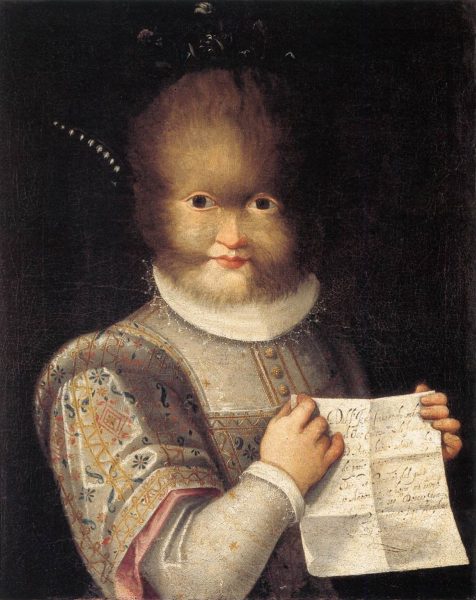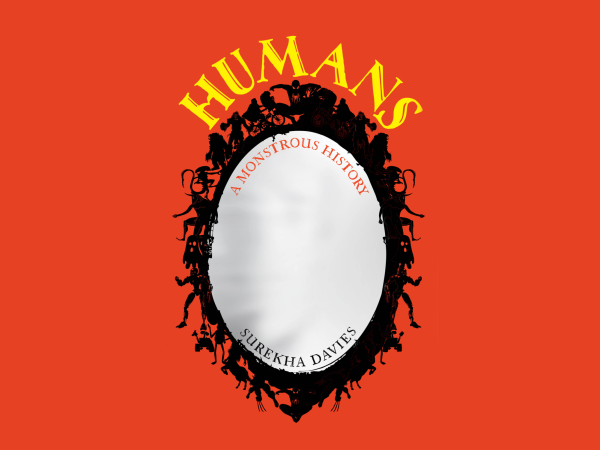
In a recent online lecture, the award-winning “historian of art, science, and ideas” Surekha Davies presented a manuscript illustration of the 16th-century courtier Antonietta Gonsalvus. Due to a rare condition known as congenital hypertrichosis universalis, Gonsalvus, along with other members of her family, experienced excessive and pervasive hair growth. In her portrait, Gonsalvus wears a luxurious red-and-white gown and a sweet smile. Her face is covered with brown hair, which supposedly, according to extant documentation, also coated the rest of her body.
Davies writes in her new book, “Humans: A Monstrous History”—the subject of the talk— “The Gonsalvus family lived much of their lives at European courts and in aristocratic villas and palaces in Paris, Parma, and Rome. . . In each setting, the family occupied an overlap between pets, exotic animals, and courtiers.” Members of the family were traded and gifted between courts, belonging to a category which designated them as possessions, a category, Davies notes, that also included enslaved people.
Davies’ wide-ranging treatise surveys the history of monsterization: the categorization, rejection, abuse and exploitation across the centuries of those considered “abnormal,” a shifting, amorphous collective which included—and includes—individuals with disabilities, birth defects or qualities deemed strange, as well as entire ethnic, cultural and social groups. “Monsters,” Davies writes, “are category breakers. . . .This process of labeling—of what I call monster-making or monstrification—reveals the limits of the categories with which societies understand and organize the world and its peoples.” It is not a book about monsters, but humans qualified as and reduced to monsters, and the many ways this dehumanization has occurred across history, or spurred its unfolding.
Monsterization is not just an othering, but a sorting into superior and inferior, an
organization of being into arbitrary and false hierarchies: the poison absorbed by the roots of oppression, slavery, colonialism, genocide. “Monstrified individuals and groups—the monsters of the archive—reveal something about the person or communities doing the naming, not the person or communities they name,” writes Davies. Monsterization has provoked both eradication or attempted eradication—forced disappearance—and sensationalization—forced spectacle, often in tandem.
As colonial regimes, for instance, were displacing, robbing and killing indigenous peoples across Africa, Asia and the Americas, natives were trafficked across the ocean and forced to perform at sideshows or otherwise put on display. In a podcast, Davies explains that monsterization narratives are often “stories people tell about what nations are legitimate and what powers they are morally entitled to wield.” “Normality” (read: whiteness, maleness, Christian faith) was considered for a centuries a “spiritual and moral contract”: an ideology of supremacy which served to validate the conquest and codified subjugation of “heathens.”
In the 17th-century Americas, so-called “black codes” “invented a new, liminal category for Black Africans transported to the colonies: lawmakers deemed them to deserve fewer rights than white people and caused them to be legally defined as chattel property and enslaved for life.” Monstrification is synonymous with dehumanization, an ever-evolving process which continually deprives humans of the civil rights, safety and freedom they are owed.
During the aforementioned podcast, Davies was asked about the monstrification at work in our current political landscape. “Monstrifying stories have been circulated for some time, [people] being reframed as threats to be disappeared in one way or another—whether that’s in detention centers, or by deciding they don’t exist because suddenly we’re going to pretend humanity lives in two genders when that has never, ever been the case—there has always been a continuum—and of course, attacking birthright citizenship.” The goal, she continues, is to push citizens towards a noncitizen status, to place people in the category of “abnormal,” a social and legal designation which serves to legitimize lawful oppression.
The etymology of “abnormal” traces back to the Latin word “abnormalis,” meaning “belonging to no clear school or party.” The purpose of making others into monsters is to exile them, to disappear them, to erase them from any ingroup. It is a way of formalizing belonging, of drawing social and legal boundaries between who is and who isn’t allowed to exist. Humans are great categorizers, but categorizing ourselves, making binary the diverse expressions of humanity, spawns violence and destruction.
Davies conceives instead of a “monstro-futurism” which casts off the yoke of the us/them mentality: “in a future in which everyone is wondrous and unique and monstrous in a good way, no one would be a monster. So that’s a kind of monstro-futurism—a better way to be.”

























